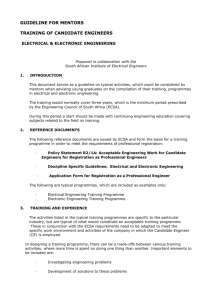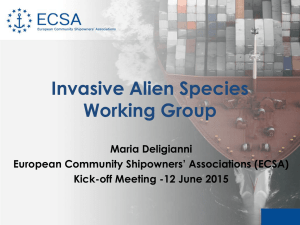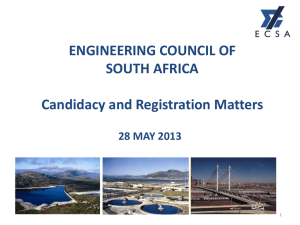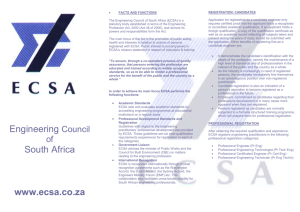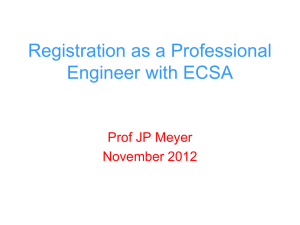Advisability and Legal Requirements for Employing Registered
advertisement
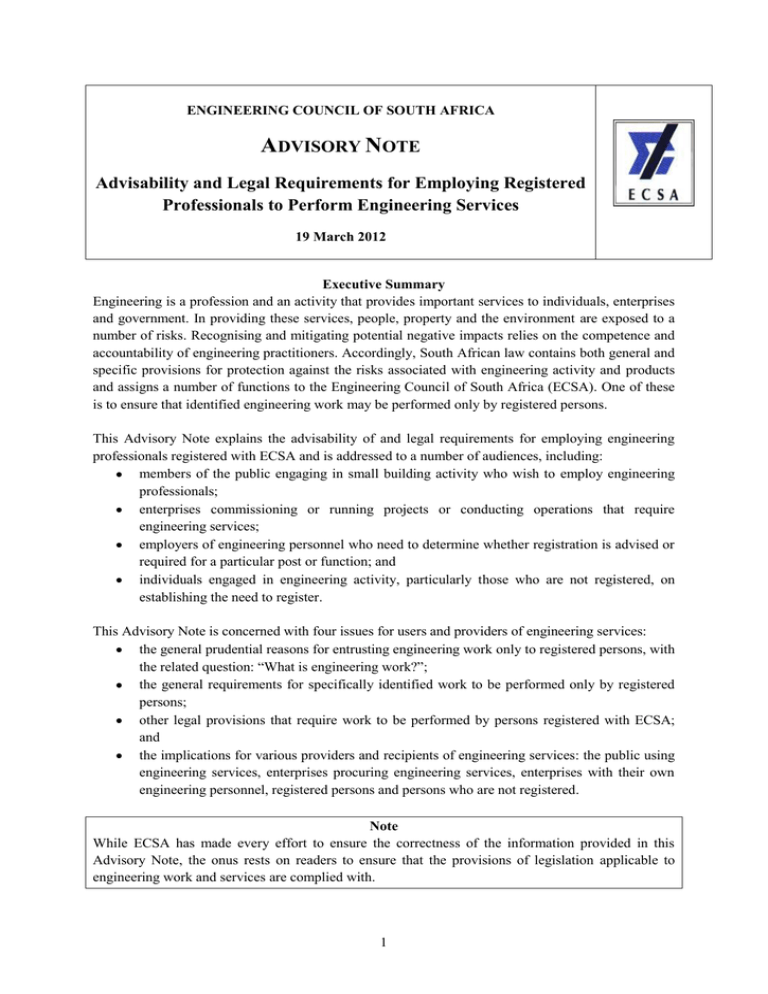
ENGINEERING COUNCIL OF SOUTH AFRICA ADVISORY NOTE Advisability and Legal Requirements for Employing Registered Professionals to Perform Engineering Services 19 March 2012 Executive Summary Engineering is a profession and an activity that provides important services to individuals, enterprises and government. In providing these services, people, property and the environment are exposed to a number of risks. Recognising and mitigating potential negative impacts relies on the competence and accountability of engineering practitioners. Accordingly, South African law contains both general and specific provisions for protection against the risks associated with engineering activity and products and assigns a number of functions to the Engineering Council of South Africa (ECSA). One of these is to ensure that identified engineering work may be performed only by registered persons. This Advisory Note explains the advisability of and legal requirements for employing engineering professionals registered with ECSA and is addressed to a number of audiences, including: members of the public engaging in small building activity who wish to employ engineering professionals; enterprises commissioning or running projects or conducting operations that require engineering services; employers of engineering personnel who need to determine whether registration is advised or required for a particular post or function; and individuals engaged in engineering activity, particularly those who are not registered, on establishing the need to register. This Advisory Note is concerned with four issues for users and providers of engineering services: the general prudential reasons for entrusting engineering work only to registered persons, with the related question: “What is engineering work?”; the general requirements for specifically identified work to be performed only by registered persons; other legal provisions that require work to be performed by persons registered with ECSA; and the implications for various providers and recipients of engineering services: the public using engineering services, enterprises procuring engineering services, enterprises with their own engineering personnel, registered persons and persons who are not registered. Note While ECSA has made every effort to ensure the correctness of the information provided in this Advisory Note, the onus rests on readers to ensure that the provisions of legislation applicable to engineering work and services are complied with. 1 1. Purpose of this Advisory Note This Advisory Note covers five main aspects of the performance of engineering work and the provision of engineering services: 1. The nature of engineering work and solutions, the benefits and associated risks, and the reasons for entrusting engineering work to registered persons (Section 2). 2. The underlying purpose of the Regulations for Identification of Engineering Work (IDoEW) for Registered Persons1, which are to be read with the Engineering Profession Act (EPA), 2000 (Act 46/2000), stated concisely, is “to safeguard public health, safety and the built environment from the impacts of engineering work.” The EPA states that “Any person who is not registered in terms of this Act …may not perform any kind of work identified for any category of registered persons…” This is to ensure that engineering work, which inherently carries high risks of negative impact on public health, safety and the environment, must be carried out by persons who have the required competencies in terms of education, qualifications, training, experience and ability – so as to minimise the risk of negative impact (Section 3.1). 3. In addition to the general requirements for registration, a number of Acts require engineering work to be performed or certified by persons registered in a stated category with ECSA (Section 3.2). 4. How identified engineering work is defined (Section 4). 5. The implications of restricting identified work for various parties (Section 5): the public using engineering services, principally in small building works where an appropriately registered person may be required to deliver the services (Section 5.1); enterprises procuring engineering services from consultants and contractors (Section 5.2); enterprises providing engineering services or having their own engineering personnel to support their operation who need to determine whether or not an individual engineer should be registered (Section 5.3); candidates and professionally registered persons generally and in particular when they work in an overlap area between ECSA categories of registration or between engineering and other professions (Sections 5.4 and 5.5); and unregistered persons who seek to carry out engineering work must determine whether the work is identified for performance by a registered person. (Section 5.5) The key consequence is that unregistered persons may not perform engineering work which has been identified to be reserved for registered persons. Therefore an employer or member of the public engaged in carrying out or using engineering services needs to be able to identify the engineering work to ensure that it is not carried out or delivered by an unregistered person. The unregistered person in turn needs to recognise whether the work is such that it should be reserved for a registered person. 1 To be published by the Minister of Public Works on completion of Council for the Built Environment processes. 2 2. Nature, Benefits, Risks and Regulation of Engineering Work Engineering is a profession and activity that is essential to meeting the needs of people, economic development and the provision of services to society. Engineering involves the purposeful application of mathematical and natural sciences and a body of engineering knowledge, technology and techniques. Critical engineering decisions rely on practical experience. Engineering seeks to produce solutions whose effects are predicted to the greatest degree possible in often uncertain contexts. While bringing benefits, engineering activity has potentially adverse consequences. Risks arise because of the means used to produce engineering solutions and products that generally exploit or attempt to control natural forces or complex processes, including: exploitation of natural resources; harnessing of energy for useful purposes; use of materials and substances with useful chemical or physical properties; use of machinery and equipment; transfer, storage and processing of information; construction, maintenance, refurbishment and demolition of buildings and engineering infrastructure; and organisation and control of systems or processes. Engineering must therefore be carried out competently, responsibly and ethically; use available resources efficiently; be economic; safeguard health and safety; be environmentally sound and sustainable; and generally manage risks throughout the entire lifecycle of a project, product or system. Engineering finds many areas of application and typically requires a range of roles with distinct knowledge and skills. The broad field of engineering is therefore organised in terms of a number of roles, namely categories of registration, disciplines, sub-disciplines and specialities. 2.1. Categories of Registration The first division of engineering roles is by category of registration. The professional categories established in Section 18(1) of the EPA are: Professional Engineer, Professional Engineering Technologist, Professional Engineering Technician, and Professional Certificated Engineer. These categories have been developed to create an engineering team with an appropriate division of functions. Profiles of the four categories are shown in the Table 1. The professional categories have similar types of generic competencies: problem analysis and synthesis of solutions, using engineering knowledge, design, investigation, impact assessment, legal compliance, applying judgement and ethical behaviour. The professional categories are differentiated by the level of problems to be solved, the complexity of engineering activities and the type of responsibility that must be taken. The last row of Table 1 summarises the distinctive roles of the four professional categories. The professional categories are formally defined by ECSA’s competency standards. 3 Table 1: Engineering Professional Profiles A Professional Certificated Engineer is, in general, comparable to the Professional Engineering Technologist, but is specially certified in occupational health and safety and in mine or plant operations. Professional Engineers have a Professional Engineering Professional Engineering broad, fundamentals-based Technologists understand the Technicians have a working knowledge of engineering engineering sciences underlying a understanding of engineering sciences, with depth in specialist deep knowledge of specific sciences underlying a set of areas, together with knowledge of technologies, together with standard processes and financial, commercial, legal, financial, commercial, legal, techniques, together with costing, social and health, safety and social and health, safety and regulatory and health, safety and environmental matters. environmental matters. environmental methodologies. They are able to solve unfamiliar They are able to apply established They are able to apply proven, problems, develop components, and newly developed engineering commonly understood techniques, systems, services and processes technologies to solve problems, procedures, practices and codes in through analysis, synthesis, develop components, systems, support of engineering activities. managing complexity, creativity, services and processes. innovation and the application of fundamental and engineering principles. They are able to conceptualise or They are able to modify They are able to apply established reframe situations by analysis, established engineering methods and procedures in synthesis and evaluation based on technology and apply newly unfamiliar situations. a well-developed grasp of developed engineering engineering theory to plan and technologies on a regular basis. design original and novel solutions to problems. They are able to provide technical They are able to provide They are able to manage and and commercial leadership, leadership in the application of supervise engineering operations, manage engineering-dependent technology in design, design construction and activities and industrial and commercial review, operational, supervisory provide technical services. enterprises and lead large and commercial activities within resource-intensive projects. their field. They are able to optimise costs They are able to ensure that They are able to ensure that and benefits to clients and engineering solutions meet engineering solutions meet community while achieving performance requirements and performance requirements and desired outcomes within the accepted minimum standards for accepted minimum standards for context of a safe and sustainable the safety and welfare of the health and safety. environment. community. They are able to work They are able to work They are able to work independently and responsibly, independently and responsibly, independently and responsibly applying original thought and applying judgement to decisions within an allocated area or under judgement to technical and riskarising in the application of guidance of an engineer or based decisions in complex technology to problems and technologist. situations. associated risks. They are able are able to assess They are able are able to approve They are able to certify the and evaluate technological or certify technical operations, quality of engineering work and possibilities for society, business compliance with performancethe condition of equipment and and government, helping ensure based criteria for safety, and the systems in defined circumstances, that policy decisions recognise design of components and subas laid down in standards and such possibilities and that costs, systems where significant new codes of practice. risks, limitations and probable development is not involved. outcomes are properly understood. Professional Engineers are Professional Engineering Professional Engineering therefore primarily concerned Technologists therefore act as Technicians therefore play an with the progress of engineering exponents of today's engineering essential role in applying proven applications and technology technology. techniques and procedures to the through innovation, creativity and solution of practical engineering change. problems. 4 For each professional category, there is a candidate category for persons who are training and gaining experience toward registration. The entry requirement to candidate registration is the completion of the education for the category, usually by means of an accredited qualification. ECSA also maintains a number of specified categories of registration, created to certify the competence and regulate the practice of persons performing specialised functions in areas of risk to persons, for example a Registered Lift Inspector. Specified categories do not require the full engineering qualifications and experience of professional categories, but rather have specialised training. Table 2: ECSA-recognised disciplines with indicative functions within the discipline Aeronautical Engineering: The design, development, operation and maintenance of aircraft and spacecraft of all types based on engineering sciences underlying flight dynamics, aerospace structures and propulsion systems. Agricultural Engineering: The planning, design, development, operation and maintenance of agricultural machinery, mechanisation, production and processing and natural resource management through the application of engineering sciences. Chemical Engineering: The planning, design, development, operation and maintenance of industrial-scale processes to convert raw and recycled materials to products through chemical and physical processes and engineering sciences: thermodynamics, fluid mechanics, transfer processes. Civil Engineering: The planning, design, construction, operation and maintenance of all types of structures for buildings, dams, bridges, roads, highways, railways, transportation systems, township services, earthworks, excavations soil conservation and geotechnical processes, water resources, pipelines, canals, water treatment, storm-water and drainage, sewerage systems, sanitation waste disposal, coastal engineering. Electrical Engineering: The planning, design, construction, operation and maintenance of materials, components, plant and systems for generating, transmitting, distributing and utilising electrical energy; electronic devices, apparatus and control systems for industrial systems, bio-medical and consumer products; computing, communication and software for critical applications instrumentation and control of processes, through the application of electrical, electromagnetic and information engineering sciences. Industrial Engineering: The planning, design, construction, operation and maintenance of industrial, manufacturing and production systems and operations, through systems engineering and supply chain management. Mechanical Engineering: The planning, design, construction, operation and maintenance of materials, components, machines plant and systems for lifting, hoisting and materials handling; turbines, pumps and fluid power; heating, cooling, ventilating and air-conditioning; fuels, combustion, engines, steam plant, turbines; automobiles, trucks and special vehicles; fire protection; nuclear energy generation; through the application of engineering sciences: mechanics, solid mechanics, thermodynamics, fluid mechanics. Metallurgical and Materials Engineering including: Physical Metallurgy: The analysis, design, production, characterisation, failure analysis and application of materials, including metals, for engineering applications based on an understanding of the properties of matter and engineering requirements. Extractive Metallurgical Engineering: The planning, design, construction, operation and maintenance of processes for the extraction of metals or intermediate compounds from ores by chemical or physical processes, including those at high temperatures. Mining Engineering: The planning, design, development, operation, maintenance and rehabilitation of works for the extraction of minerals from natural deposits on the earth’s surface, underground or under-water. 2.2 Engineering Disciplines The second useful, but less rigid, division of engineering practitioners is by discipline. ECSA and the engineering community have found it useful to identify the nine broad disciplines listed and described in the Table 2. ECSA accommodates persons in cross-disciplinary areas, for example in Mechatronics and in emerging areas, for example Bio-medical Engineering. 5 Disciplines shown in Table 2 are broad: it is unlikely that a single practitioner will span the whole field and many sub-disciplines exist. Disciplines also have overlaps. Most disciplines have a comparable foundation in mathematics and natural sciences. Significant commonality exists in engineering fundamentals, for example Chemical and Mechanical Engineering build on thermodynamics while Mechanical and Civil Engineering build on the theory of structures. Within each discipline there are numerous specialisations or sub-disciplines that evolve with the progress of engineering science and technology. 3. Legislative Provisions Legislation governing the practice of engineering is both general and specific. General provisions are contained in the Engineering Profession Act, 2000 (EPA) (No. 46 of 2000). Specific provisions exist in a number of other Acts. 3.1 The Engineering Profession Act The EPA establishes the professional and candidate categories and defines the requirements for registration. An applicant for registration must demonstrate competency against standards for the category determined by the ECSA Council. These standards are defined in published competency standards that represent the required entry-level performance for registration. Section 27 of the EPA empowers ECSA to draw up a Code of Conduct for registered persons and also to draw up a Code of Practice when deemed necessary. The ECSA Code of Conduct contains a specific provision to the effect that a registered person must only perform work that his or her education, training and experience have rendered him or her competent to perform. There is therefore a self-regulation element to professional practice. Failure to work only within one’s area of competence may result in a disciplinary process with ECSA. Section 18(2) of the EPA prohibits any person not registered in any ECSA category from practising in the category. ECSA takes the term practise in a category to have the same meaning as performing engineering work identified for the category as described in Section 4 below. Persons registered in a Candidate category are permitted to perform identified engineering work for the category provided this is done under supervision and control of a registered person. Persons registered in a professional category are permitted to practise in a consulting capacity in that category. The specific provision for IDoEW is in Section 26 of the EPA. ECSA must propose identified work. Section 26(4) states that any person who is not registered may not perform identified engineering work unless performed under supervision and control of a registered person, who shall take responsibility for the work. The identified work proposed by ECSA must, under Section 20 of the Council for the Built Environment Act (No 43 of 2000) be “identified” by the Council for the Built Environment (CBE) for any category of registered person and promulgated as a regulation2. 2 At the time of writing, the CBE has not completed this action. 6 Identification of Engineering Work applies to all professional categories. Persons performing work under a Government Certificate of Competency issued in terms of the Mine Health and Safety Act (MHS) or Occupational Health and Safety (OHS) Act and Merchant Shipping Act must register as a Professional Certificated Engineer if performing identified work. The reason for this is that such engineers generally perform work comparable with the Professional Engineering Technologist that goes beyond the specific provisions of the MHS or OHS Acts. Work identified for specified categories is defined in the rules published for each category. Engineering has areas of overlap with other built environment professions, namely Architecture, Landscape Architecture, Quantity Surveying, Construction Project Management and Construction Management, as well as cognate professions such as Land and Technical Surveying, Town Planning and Engineering Geology. The approach of the proposed regulations is to permit professionals to practise in the overlap area provided that their education, training, experience and contextual knowledge has rendered them competent to perform such engineering work and that the substantial part of their practice is not in the overlapped profession. The engineering team extends beyond the four professional categories. Important functions are performed by draftspersons, supervisors, inspectors, artisans and operators. Identification of Engineering Work prevents such persons, along with all other unregistered persons, from performing work defined for the ECSA registration categories except under the supervision of a registered person. 3.2 Statutory Duties of Registered Persons under other Acts The performance of engineering activities is frequently governed by parts of other statutes. Such activities, referred to here as statutory duties, are generally applicable to designated positions or titles, and the scope of their work which is subject to the relevant statutes is summarised below. This list is not exhaustive. Aircraft Maintenance Engineer/Instructor, Flight engineer: Performs duties in terms of the Aviation Act 74 of 1962. Chief Engineer (marine) or Engineer (marine) Officer: Performs duties in terms of the Merchant Shipping Act 57 of 1951. Lift Inspector: Performs duties in terms of the Occupational Health and Safety Act 85 of 1993. Biomedical Engineer: Functions as a biomedical engineer in terms of the Health Professions Act 56 of 1974. Approved Professional Person for Dam Engineering: Performs duties in terms of the National Water Act 36 of 1998. Water Resources Engineer: Approve plans, specifications and design reports in terms of section 12 of the National Water Act 36 of 1998 relating to: (a) Construction of any surface dam to impound waste, to prevent pollution of a water resource, (b) Implementation of pollution control measures, to prevent pollution of a water resource, and (c) Implementation of water control measures, to prevent pollution of a water resource.. National Building Regulations and Building Standards Act 103 of 1977, (or the Housing Consumers Protection Measures Act 95 of1998, where applicable): 7 Structural Engineer: (a) Certify structural system of a building or home. (b) Report in terms of the Sectional Titles Act 95 of 1986 on the general physical condition of building with specific reference to any defects and related services and facilities. Geotechnical Engineer/Engineering Geologist (general): (a) Conduct geotechnical site investigations in accordance with the National Building Regulations and Building Standards Act 103 of 1977, or the Housing Consumers Protection Measures Act 95 of 1998, on sites other than those underlain by dolomites, (b) Determine precautionary measures relating to the stability of excavations in terms of the National Building Regulations. Geotechnical Engineer/Engineering Geologist (dolomite areas): Conduct geotechnical investigations on sites underlain by dolomites in accordance with the National Building Regulations and Building Standards Act 103 of 1977, or the Housing Consumers Protection Measures Act 95 of1998. Certification of fire protection systems in accordance with the National Building Regulations and Building Standards Act 103 of 1977. National Building Regulations and Building Standards Act 103 of 1977: Certification of artificial ventilation systems. Occupational Health and Safety Act (Act No 85 of 1993): (a) General Machinery Regulations, (b) Construction Regulations, (c) Driven Machinery Regulations, (d) Pressurised Equipment Regulations, (e) Explosives Regulations: Building plans for all dangerous buildings or works. Mine Health and Safety Act (Act 27 of 1996): (a) Design of underground dam walls, plugs and barricades (b) Regulations on use of water for mining (c) Certificated Electrical Engineer and Certificated Mechanical Engineer Mine Manager3: Performs duties in terms of the Minerals Act, 1991 Act 50 of 1991. 4. What is Identified Engineering Work? A test is required for engineering work that must be performed in a responsible capacity only by a person registered in a category. The test must be based on a definition of the identified work. The existence of several categories of registration and the wide range of areas in which a person can practice mean that it is impracticable to provide a detailed description at a functional level of every known and evolving practice area in engineering. This contrasts with some of the other built environment professionals who perform in a much narrower field and are able to define the work of that profession in detail and list the tasks and parameters of the work identified for their professions. Consequently ECSA has adopted a “generic” approach to identifying engineering work that should be reserved for registered persons. The objective is to determine firstly, whether the work falls above an identification threshold and secondly, having fallen above the threshold, which category of registration would be required for performing the work. The test has three steps: 1. Does the work fall anywhere in the listed generally accepted types of engineering work? The types cover the range of disciplines, industries and services in which engineering is practised and the common risk factors associated with the work, such as those listed in 3 Normally trained as a Mining Engineer 8 section 2 and situations where information is inexact or incomplete or uncertainty prevails. 2. Does the work require performance of any of the defined engineering professional competencies? These are defined in the competency standard and include problem analysis and solution synthesis; application of engineering knowledge that is based on engineering sciences; engineering management; impact analysis and mitigation, and judgement. Steps 1 and 2 may have to be applied iteratively. Obtaining “yes” answers to both questions, means that the work is identified and must be the performed by a registered person. The test should be applied to different components of the work involving critical decisions4. It should be applied to all levels of the work where decisions are made on which other parts of the work depend. Irrespective of the level, a registered person must take responsibility for the work. The third question identifies the category whose competence is required for the work. 3. At what category level must the competencies in step 1 be performed in relation to the level descriptors contained in the competency standard for the category? If the work is a statutory duty, registration in the stated category is required in terms of the relevant legislation. Registration is required, irrespective of the outcome of the test. Table 3: Common Combinations of Service Provider and Employer Type of Employer (Client) Individual or group Enterprises: private Public: all spheres Service Provider of individuals (incl. not for profit) of government or state Single Practitioner If work passes identification test, or Mainly small statutory provision applies, Provider building work: must have registered person at decision Consulting Firm NBR* apply making level Contractor Several statutory provisions may apply. If contractor has to make engineering decisions, for example in on-site design, the principle applies Enterprises: private or state Unlikely case, but In-house engineering services: If work key principle would passes identification test, or statutory apply if applicable provision applies, organisation must have Public: all spheres of government registered person at all critical engineering decision making levels * NBR = National Building Regulations The formal definition of identified work is of necessity technical. The test must therefore be performed by engineering peers, that is persons with knowledge of the field in which the work falls 4 A critical decision is one that, if not taken correctly, has potential consequences for the quality of the overall solution, health, safety, or the environment. 9 and having engineering competency. It has not proven possible to devise a test that can be applied by a person without this knowledge of the engineering profession and engineering practice. While not the primary objective of IDoEW, the test, and particularly step 3, can be applied in cases where a person registered in one professional category is performing work that requires the [greater] competence of another category. 5. What are the Implications of Identification of Engineering Work? The objective of legally restricting the performance of identified engineering work to persons registered in an appropriate category with ECSA is to ensure that the work is performed competently, that risks associated with the work are mitigated and the practitioners are accountable for the work. The following discussion is built on the key principle that the person(s) who make critical engineering decisions at any level and carry responsibility for those decisions must be registered in the appropriate category. This principle applies whenever an engineering service is provided, both by a provider to a client and in-house in an organisation. Several types of providers of engineering services, including in-house provision, as well as a range of clients or employers are identified in the Table 3. How the principle plays out in a number of situations is reviewed below. 5.1 For the Public Using the Services of Engineering Practitioners The use of engineering services by individuals or groups of individuals occurs most frequently in small building works. An Advisory Note5 guides members of the public who engage engineering professionals in the course of small building works. Such work is governed by the National Building Regulations that identifies functions that require the services of a registered professional. While the Advisory Note on small building works details the working relationship between the client and consultant, the relationship relies on a high degree of self-regulation by the consultant. The consultant should confirm to the client if the work is reserved, and also to determine the registration category of the practitioner needed to execute the work, considering its level of complexity. The crux is a sufficient and appropriate level of competence of the practitioner; here the employer has to rely on the practitioner’s portfolio of evidence of competence and his or her assurance that he or she has the requisite competence. 5.2 For Enterprises Procuring Services of the Engineering Profession As shown in Table 3, an important case is where enterprises employ the services of consultants and contractors. Examples of employing authorities in the public sector occur in all spheres of government, particularly those bodies responsible for the delivery, operation and maintenance of infrastructure and infrastructure-related services. An important form of service delivery includes municipal services. 5 See ECSA Advisory Note: The Role, Responsibilities and Conduct of Persons Registered with ECSA Appointed for Small Building Works. 10 In the private sector clients comprise all those institutions involved in planning, development, design and creation of engineering projects such as buildings, industrial facilities, mining works, marine works, power plants, processing plants, energy projects, transport, communications, and similar. Engineering activities can include operation, maintenance, management, and also teaching, training and mentoring. Such work should be subjected to the identification test, if its status is not already known. If it falls into the identified class, as is likely in many instances, all decisions involving responsibility must be made by persons registered in the relevant category. 5.3 For Enterprises with Engineering-intensive operations Enterprises, including public and private providers of goods and services that depend on engineering work for their operation should likewise subject their various forms of work to the identification test. A positive test result indicates that the competence of an appropriately registered professional is required for effective performance of the work in a decision-making capacity. This in practice means that the need must be established for registered persons to be in positions in the organisation where critical engineering decisions on identified work are made. Engineering personnel who make critical decision and carry the responsibility for the decisions must be registered. The Chief Executive Officer would, for example, not need to be registered if he or she acts upon engineering decisions made by others who are registered and carry the responsibility for those decisions. Organisations or authorities who include engineering activities in their operations should to review their structures to identify those key posts which must be occupied by registered persons. It should be borne in mind that unregistered persons may perform engineering work, provided this is under direct control and supervision of a registered person who takes responsibility for the work. To ensure that appropriate key posts are identified for registered persons, some rearrangement of reporting lines and job descriptions in the organisation’s structure may be necessary. 5.4 For Persons Registered in Professional Categories ECSA does not consider it feasible to produce a schedule of work items, across all 9 disciplines and all 4 categories. Instead, ECSA defines work to be identified in generic terms by applying the sets of criteria described in Section 4. Reliance is placed on the ethics of the practitioner who gives the assurance that he or she possesses the necessary level of competence to undertake the work concerned in compliance with ECSA’s Code of Conduct and Code of Practice. The former code regulates behaviour and the latter regulates engineering practice. In complying therewith the person warrants that he or she will undertake only those tasks for which he or she is competent, and will exercise appropriate skill and judgement. In terms of the Act and Regulations, ECSA is empowered to sanction registered persons who contravene these codes. ECSA is aware that significant overlaps exist in the engineering activities undertaken by registered Professional Engineers, Engineering Technologists, Certificated Engineers and Engineering Technicians. ECSA accepts that persons registered in a category with ECSA may perform work in a different category should their education, training and experience render them competent to do so. Within an organisation this provides useful flexibility by allowing a person registered in one category, who has been specially trained, to perform in a more demanding category. If this becomes the 11 person’s responsibility or substantial practice he or she should register in the other category. It is important to note that, in terms of the Code of Conduct a person, who is registered in one category and is not competent to do work above that category’s capability, should decline to undertake that work and refer it to a professional who is competent to undertake that work. 5.5 For Persons Registered in Candidate Categories The EPA defines candidate categories of registration corresponding to the professional categories listed in section 2.1. A person who has met the educational requirement for the category and is being trained and gaining experience toward professional registration should register as a candidate. The candidate must not undertake identified engineering work unless under the supervision and control of a registered professional who must take responsibility for the work. Typically, candidates progress from first observing and assisting in the work of professionals to contributing to the work with diminishing levels of detailed supervision and increasing responsibility to the supervisor. Candidates will inevitably progress to doing work that is identified. While the candidate may perform identified work, including making recommendations on critical decisions to the supervisor, the supervisor must authorise the critical decisions on the basis of full information from the candidate and take responsibility for those decisions. 5.6 For Unregistered Persons It follows from the above, that a person who is not registered with ECSA in an appropriate category, and who undertakes identified engineering work, is in contravention of the EPA. It is essential therefore to have a professional apply the test for Identified Engineering Work described in Section 4 and for the unregistered person to not undertake the work it if it turns out to be identified. 6. Benefits of Identification of Work The most significant benefits to be seen from Identification of Work are as follows: Avoidance of incompetent persons performing engineering work, to the detriment of standards that lead to harmful effects on the public at large. Lowering the risk of negative impacts on public health, safety and the environment arising from engineering work. The lowering of the risk is underscored by full and individual professional accountability on the part of the persons performing the work. Providing ECSA with the means to enforce the registration of unregistered persons performing identified engineering work, and bring them into compliance with ECSA’s Code of Conduct and Code of Practice. Ensuring that the current high level of professionalism and standards of service delivery in all engineering activities including planning, design, construction, operation, maintenance, management and teaching are upheld, while maintaining international recognition and global competitiveness. The costs associated with the benefits cannot be quantified. Suffice it to say that the cost of implementation of IDoEW will be more than offset by the saving in costs to remedy mishaps and to compensate for hardships that will be avoided. 12
